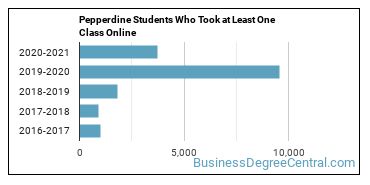Pepperdine University Business Programs
Pepperdine University is a private not-for-profit institution located in Malibu, California. Pepperdine is located in a safe and convenient suburb.
Featured schools near , edit
Where Is Pepperdine University?

Contact details for Pepperdine are given below.
| Contact Details | |
|---|---|
| Address: | 24255 Pacific Coast Hwy, Malibu, CA 90263 |
| Phone: | 310-506-4000 |
| Website: | www.pepperdine.edu |
How Do I Get Into Pepperdine?
You can apply to Pepperdine online at: https://seaver.pepperdine.edu/admission/application/undergraduate
Admission Requirements for Pepperdine
| Submission | Required? |
|---|---|
| High School GPA | 1 |
| High School Rank | 3 |
| High School Transcript | 1 |
| College Prep Program | 3 |
| Recommendations | 1 |
| SAT or ACT Scores | 5 |
| TOEFL | 1 |
How Hard Is It To Get Into Pepperdine?
Approximately 39% of accepted students are men and 61% are women. The acceptance rate for men is 52%, and the acceptance rate for women is 47%.
Average Test Scores
About 16% of students accepted to Pepperdine submitted their SAT scores. When looking at the 25th through the 75th percentile, SAT Evidence-Based Reading and Writing scores ranged between 650 and 730. Math scores were between 635 and 750.
Can I Afford Pepperdine University?
The net price is calculated by adding tuition, room, board and other costs and subtracting financial aid.
Student Loan Debt
It's not uncommon for college students to take out loans to pay for school. In fact, almost 66% of students nationwide depend at least partially on loans. At Pepperdine, approximately 41% of students took out student loans averaging $7,724 a year. That adds up to $30,896 over four years for those students.
Pepperdine University Undergraduate Student Diversity

There are also 6,738 graduate students at the school.
Gender Diversity
Of the 3,427 full-time undergraduates at Pepperdine, 42% are male and 58% are female.

Racial-Ethnic Diversity
The racial-ethnic breakdown of Pepperdine University students is as follows.

| Race/Ethnicity | Number of Grads |
|---|---|
| Asian | 456 |
| Black or African American | 153 |
| Hispanic or Latino | 577 |
| White | 1,608 |
| International Students | 309 |
| Other Races/Ethnicities | 324 |
Geographic Diversity
California students aren't the only ones who study at Pepperdine University. At this time, 39 states are represented by the student population at the school.
Over 90 countries are represented at Pepperdine. The most popular countries sending students to the school are China, Saudi Arabia, and Indonesia.
Online Learning at Pepperdine University
The following chart shows how the online learning population at Pepperdine has changed over the last few years.

The following table shows the 1-year growth rate of Pepperdine majors that offer at least one online course. This table only includes majors with positive growth.
| Major | 1-Year Growth Rate |
|---|---|
| Organizational Leadership | 12% |
Pepperdine University Business Concentrations
The table below shows the number of awards for each concentration.
| Major | Bachelor’s | Master’s | Doctor’s | TOTAL |
|---|---|---|---|---|
| General Business Administration and Management | 218 | 448 | 11 | 677 |
| International Business/Trade/Commerce | 24 | 107 | 0 | 131 |
| Organizational Leadership | 0 | 76 | 0 | 76 |
| Management Science | 0 | 60 | 0 | 60 |
| Other Public Relations, Advertising, & Applied Communication | 56 | 0 | 0 | 56 |
| General Economics | 51 | 0 | 0 | 51 |
| Advertising | 48 | 0 | 0 | 48 |
| General Human Resources Management/Personnel Administration | 0 | 46 | 0 | 46 |
| Real Estate | 0 | 24 | 0 | 24 |
| Public Relations, Advertising, & Applied Communication | 18 | 0 | 0 | 18 |
| Accounting | 15 | 0 | 0 | 15 |
| Finance | 8 | 0 | 0 | 8 |
| International & Intercultural Communication | 3 | 0 | 0 | 3 |
| General Organizational Communication | 2 | 0 | 0 | 2 |
| International Business, Trade, & Tax Law | 0 | 2 | 0 | 2 |
| Human Resources Development | 0 | 1 | 0 | 1 |
| Other Management Sciences and Quantitative Methods | 0 | 1 | 0 | 1 |
| TOTAL | 443 | 765 | 11 | 1,219 |
References
*The racial-ethnic minorities count is calculated by taking the total number of students and subtracting white students, international students, and students whose race/ethnicity was unknown. This number is then divided by the total number of students at the school to obtain the racial-ethnic minorities percentage.
- College Factual
- National Center for Education Statistics
- Image Credit: By Infratec~commonswiki under License
More about our data sources and methodologies.
Featured Schools
You have goals. Southern New Hampshire University can help you get there. Whether you need a bachelor's degree to get into a career or want a master's degree to move up in your current career, SNHU has an online program for you. Find your degree from over 200 online programs.
Visit School
